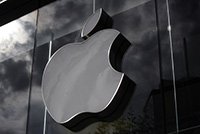There's no sugarcoating it. Apple stock (NASDAQ: AAPL) is taking it on the chin today (Thursday, Jan. 3) and taking much of the stock market with it.
 AAPL shares were down about 9% in early trading following a rare earnings warning from CEO Tim Cook. How rare? The last one was issued by Steve Jobs - in 2002.
AAPL shares were down about 9% in early trading following a rare earnings warning from CEO Tim Cook. How rare? The last one was issued by Steve Jobs - in 2002.
The Apple stock price is now down about 37% from its all-time high of $233.47 reached on Oct. 3. The steep decline has Apple investors worried, but this isn't as bad as it looks.
Here's what's going on. The part of Cook's letter that has Wall Street panicking is a revision to the revenue guidance for the just-ended quarter (Apple's fiscal Q1).
In its last earnings call, Apple said it expected revenue for Q1 to fall between $89 billion and $91 billion. Cook's letter lowered that figure to $84 billion - a drop of about 7%.
LIVE ON CAMERA: Watch America's No. 1 Pattern Trader officially become $1,050 richer in 15 seconds! His secret to becoming a multimillionaire is so easy that anybody can do it. Click here for details...
That's bad enough. But Cook said the main reason for the revision is lower-than-anticipated iPhone sales in China. Given Wall Street's long obsession over any hiccup in iPhone sales, this news was more than enough to send the stock tumbling.
Cook pointed to the Chinese economic slowdown as well as U.S. President Donald Trump's increasingly damaging trade war as root causes for its difficulties in China. He added that sales in China of Apple's other products, such as the Mac and iPad, were also lower than expected.
While this is certainly not good news, investors need stay focused on the big picture here. One difficult quarter doesn't mean Apple's sales in China are now doomed to spiral downward. (Not helping: a gratuitous report from Citi entitled "What if China Sales Went to Zero?")
Most news reports are ignoring elements of Cook's letter that indicate the sky is not in fact falling...
Why You Shouldn't Sell Your Apple Stock Now
For example, Cook said Apple is still expected to report a new all-time record for earnings per share. And the outlook for gross margins remains the same, at about 38%.
Cook noted that despite the issues in China, Apple will report revenue records in many other countries, including the United States, Germany, Korea, Mexico, and Malaysia.
Non-iPhone revenue grew almost 19% year over year, Cook added, with wearables (the Apple Watch and AirPods) growing by an impressive 50%.
Cook also mentioned the continuing growth of services revenue, a piece of Apple's business we at Money Morning have been focusing on for the past several years.
Investors should keep in mind that Apple is transitioning from a hardware business to a services business. That means glitches in quarterly iPhone sales will matter less in years to come, as services becomes the more meaningful source of revenue.
So if you hold Apple stock now, resist the urge to dump it - it will recover and then some. And if you don't own AAPL stock, now is a great time to buy. I still believe Apple can reach $300 by 2020, which represents a gain of more than 100% from the current depressed price.
This storm will pass.
This Easy-to-Follow Blueprint Could Make You $15,000 Richer
America's No. 1 Pattern Trader used to be an average Joe scraping to get by. He never graduated from college, and he spent most of his career as a Home Depot customer service rep.
He didn't want to be stuck at a job he didn't like until he was 80 - so he taught himself how to trade. He found he had a knack for it, and he became richer than he ever thought possible.
Then he invented his patent-pending Money Calendar, and he knew it could change people's lives.
Now, for the first time ever, he's revealing all his trading secrets and strategies - so you can amass a fast fortune for yourself.
Step by step, click by click, he'll guide you through setting up your account - and show you how to set up a series of take-it-to-the-bank payouts of $605... $822... $1,190... $2,830 every single week.
There's no guesswork involved, and the best part is - it'll only take you 10 minutes per day! Click here now to start this once-in-a-lifetime journey...
Follow Money Morning on Facebook, Twitter, and LinkedIn.
About the Author
David Zeiler, Associate Editor for Money Morning at Money Map Press, has been a journalist for more than 35 years, including 18 spent at The Baltimore Sun. He has worked as a writer, editor, and page designer at different times in his career. He's interviewed a number of well-known personalities - ranging from punk rock icon Joey Ramone to Apple Inc. co-founder Steve Wozniak.
Over the course of his journalistic career, Dave has covered many diverse subjects. Since arriving at Money Morning in 2011, he has focused primarily on technology. He's an expert on both Apple and cryptocurrencies. He started writing about Apple for The Sun in the mid-1990s, and had an Apple blog on The Sun's web site from 2007-2009. Dave's been writing about Bitcoin since 2011 - long before most people had even heard of it. He even mined it for a short time.
Dave has a BA in English and Mass Communications from Loyola University Maryland.



